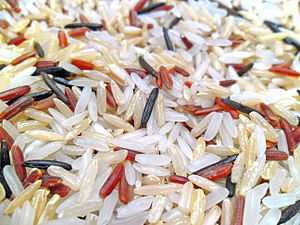Jasmine rice

Jasmine rice (Thai: ข้าวหอมมะลิ; rtgs: Khao hom mali; Thai pronunciation: [kʰâːw hɔ̌ːm malíʔ]; Vietnamese: Gạo thơm thượng hạng; Chinese: 泰国香米), also known as Thai hom mali or Thai fragrant rice, is a long-grain variety of rice that has a sweet aromatic fragrance, a subtle pandan-like (Pandanus amaryllifolius-leaves) aroma caused by 2-acetyl-1-pyrroline.[1] Jasmine rice is grown primarily in Thailand, and to a lesser degree in Laos, Cambodia, and southern Vietnam. The grains cling and are somewhat sticky when cooked, though less sticky than glutinous short-grain rice (Oryza sativa var. glutinosa), as it has less amylopectin. It is still about three times more sticky than American long-grain rice. It is moist and soft in texture when cooked, with a slightly sweet flavor. Like with other rices, freshness and maximal fragrance is retained within six months from the time it is harvested, after which the rice becomes dry and fragrance decreases when cooked.[2]
To harvest jasmine rice, the long stalks are cut and threshed. The rice can then be left in a hulled form and sold as brown rice or shucked and sold as white rice.
Types
Cambodian and Thai jasmine rice share the same characteristics and grow mainly in neighbouring geographic areas on opposite sides of the northeastern Thai-Cambodian border. Cambodian jasmine rice (Khmer: phka malis) is cultivated in Cambodia and processed as white (milled and polished) and brown rice. Distinct Cambodian jasmine rice varieties include these major three, namely phka rumduol, phka romeat, and phka rumdeng. Recent DNA fingerprint analysis, carried out with 18 markers, shows that all three varieties possess 18 known fragrance alleles. Two varietals (phka rumduol and phka rumdeng) are distinct Cambodian with 17 markers in identical positions, with Thai jasmine rice and one fragrance marker each in a different position. The analysis of Cambodian phka romeat shows all 18 markers in identical positions with the trademarked Thai jasmine rice Thai hom mali. [3]
Jasmine rice, though grown in Laos and southern Vietnam, is not the predominant rice variety; glutinous rice is grown in Laos, and regular Oryza sativa predominates in Vietnam.
Thai jasmine rice from Thailand has a slender shape and a jasmine scent.[4] The two types of Thai jasmine rice are white and brown.[5] Vast majority of jasmine rice exported overseas to North America and Europe is Thai jasmine rice, and a small minority from Vietnam.
White jasmine rice

White jasmine rice is white, has a jasmine aroma and, when cooked, a slightly sticky texture.[6] The aroma is caused by the evaporation of 2-Acetyl-1-pyrroline.[6]
Brown jasmine rice
Brown jasmine rice retains the light tan outer layer on the rice grain.[7] It has greater health benefits than white jasmine rice because it still has the bran.[8] Brown jasmine rice has a flavor like oats and contains gamma oryzanol which can decrease cholesterol in blood vessels.[9] Brown jasmine rice has vitamins such as vitamin A, vitamin B and beta-carotene[10] and it contains antioxidants which support the working of nervous system.[7]
Glycemic index
Jasmine rice has a very high glycemic index of 109, which is more than pure glucose.[11] Foods with a glycemic index of 70 or lower are preferred in the diet due to their slower absorption which prevents large spikes in blood sugar after consumption. Not all rice has a high glycemic index, basmati rice for example, has a relatively low glycemic index of 59.
Culinary uses
Steamed jasmine rice is ideal for eating with stir-fries, with grilled, fried or braised food items, and in soups (when cooked slightly drier by adding a little less water during cooking). It often doesn't fare well when used for fried rice, as it's too soft and soggy when cooked and fried rice requires a dry, more firm variety of rice such as American long-grain to prevent sogginess when cooked.
See also
- Ambemohar
- Basmati rice
- List of rice varieties
- Oryza sativa
- Wehani rice
- Glutinous rice
References
- ↑ S. Wongpornchai, T. Sriseadka, S. Choonvisase (2003). "Identification and quantitation of the rice aroma compound, 2-acetyl-1-pyrroline, in bread flowers (Vallaris glabra Ktze)". J. Agric. Food. Chem. 51 (2): 457–462. doi:10.1021/jf025856x. PMID 12517110.
- ↑ "What is Jasmine Rice?". wiseGEEK. Conjecture Corporation.
- ↑ http://www.cardi.org.kh/index.php?page=detail&ctype=article&id=212&lg=en
- ↑ K. Khunket, A. Wutthanet, A. Prasertsak, S. Traprap, K. Cheungpun, W. Chamalerk, K. Nakrang, S. Wongpiyachon, B. Warinruk, P. Mekawutthanakarn, S. Jaidee, N. Piyachotisakulchai, P. Srikhum, R. Changsri, T. Cheunban, W. Ruttanakarn, W. Khemmuk. ข้าวขาวดอกมะลิ 105. THAILAND: กรมการข้าว สำนักวิจัยและพัฒนาข้าว. pp. 12–13.
- ↑ W. Leanjumroon, N. Yuwanaboon. หอมกลิ่นข้าวมะลิหอม. THAILAND: BIOTHAI. p. 10.
- ↑ 6.0 6.1 K. Khunket, A. Wutthanet, A. Prasertsak, S. Traprap, K. Cheungpun, W. Chamalerk, K. Nakrang, S. Wongpiyachon, B. Warinruk, P. Mekawutthanakarn, S. Jaidee, N. Piyachotisakulchai, P. Srikhum, R. Changsri, T. Cheunban, W. Ruttanakarn, W. Khemmuk. ข้าวขาวดอกมะลิ 105. THAILAND: กรมการข้าว สำนักวิจัยและพัฒนาข้าว. pp. 8–13.
- ↑ 7.0 7.1 "The benefits of Thai jasmine rice". welovelb. Retrieved October 20. Check date values in:
|accessdate=(help) - ↑ "Benefits of Brown jasmine rice". Manob Keawsanid. Retrieved October 20, 2013.
- ↑ "Jasmine Rice Health Benefits, Nutrition Facts". diethealthclub. Retrieved October 20, 2013.
- ↑ "The benefits of jasmine rice". Hommali. Retrieved October 27, 2013.
- ↑ http://www.diabetesinfo.org.au/about-diabetes/diabetes-management/food-and-nutrition-management/choose-good-carbohydrates-with-low-gi. Missing or empty
|title=(help)
| ||||||||||||||||||||||||||||||||||
